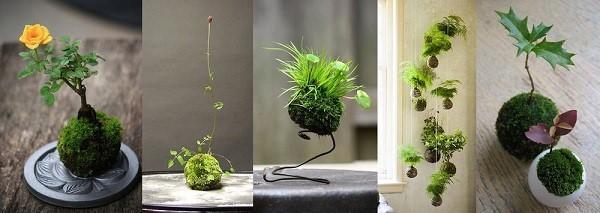DIY bonsai for the poor or kokedama
 One of the newest trends in the art of bonsai is considered to be kokedama. It has existed as an independent technique for about twenty years, but its popularity has spread far beyond Japan.
One of the newest trends in the art of bonsai is considered to be kokedama. It has existed as an independent technique for about twenty years, but its popularity has spread far beyond Japan.
The word "kokedama" is translated as "moss bumps".
Benefits of kokedama over bonsai
The main advantage of kokedama is the speed of its creation. Unlike bonsai, which takes quite a long time to form, making kokedama much faster, and to admire the result, you don't have to wait several years. In addition, the kokedama does not require pots, which is why it is often referred to as "bonsai for the poor."
The peculiarity of kokedama is that the roots of the plant are entwined with soil in the shape of a ball and are covered with moss on top, which serves for an aesthetic appearance and retaining moisture.
What is the difference between kokedama and bonsai?
Despite some similarities, there are still differences between the two techniques:
- Bonsai requires compliance with strict rules of cultivation and further care, and when forming kokedama, only the flight of the author's imagination is important.
- Only woody plants are suitable for bonsai, but kokedama can be created from any culture (orchids, ferns, lianas and many others).
The only condition for creating a kokidama is proportions.
How to make a kokedama?
To make a kokedama, you need to prepare a base - potting soil. It can be made from ordinary garden soil mixed with peat.
In flower shops, a ready-made potting soil mixture called akadama is sold.
The further procedure is simple:
- Make a ball out of the soil with your hands, adding water.
- Remove the selected plant from its pot and remove the soil from the roots.
- Place the flower on top of the ball and braid it with roots, moistening with water.
- Close the roots tightly with moss on top.
- Secure the moss with fishing line or jute cord.
You can place the plant not on top, but inside the coma, forming an earthen ball around it.
Kokedama care
Over time, the roots will wrap around the entire soil ball or fill it up, making it strong. Once every two to three days, the kokedam must be watered by immersing it in a container of water for 15 minutes. Excess liquid should be lightly squeezed out by hand. Spray the moss periodically, which will allow it to return freshness and a bright shade. It can also be replaced with a fresh one.
The need for watering is evidenced by the loss of weight by the moss ball - it becomes light.
Liquid top dressing should be done once a month in summer. Depending on the selected plant, it is periodically pruned and dried leaves are removed.